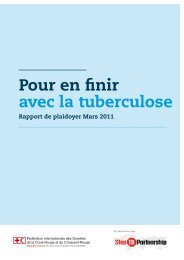Thailand - Stop TB Partnership
Thailand - Stop TB Partnership
Thailand - Stop TB Partnership
You also want an ePaper? Increase the reach of your titles
YUMPU automatically turns print PDFs into web optimized ePapers that Google loves.
48. See, e.g., J. Ngamvithayapong, et al. “Health seeking behaviour and diagnosis for pulmonary<br />
tuberculosis in an HIV epidemic mountainous area of <strong>Thailand</strong>,” International Journal of Tuberculosis<br />
and Lung Diseases, 2001; 5 (11): 1–8.<br />
49. A. Soonthorndhada, et al., Community Perceptions and Experiences of <strong>TB</strong> in Kanchanaburi, <strong>Thailand</strong>:<br />
A Gender Equity Analysis, Institute for Population and Social Research, Mahidol University, 2003,<br />
Publication No. 287.<br />
50. Comments by Rev. Sanan Wutti, The Church of Christ in <strong>Thailand</strong>, and Prasert Dechabon, President,<br />
Northern PWA Network, Public Health Watch roundtable meeting, Chiang Mai, December 9, 2005.<br />
51. UNDP, “<strong>Thailand</strong> at a Glance,” You And AIDS: The HIV/AIDS Portal for the Asia Pacific, available at<br />
http://www.youandaids.org/Asia%20Pacific%20at%20a%20Glance/<strong>Thailand</strong>/index.asp (accessed May<br />
11, 2006).<br />
52. Comments by multiple participants, Public Health Watch roundtable meeting, Bangkok, December 6,<br />
2005.<br />
53. WHO, Global Tuberculosis Control: Surveillance, Planning, Financing, (Geneva: WHO, 2006), p. 122.<br />
54. The <strong>Thailand</strong> Millennium Development Goals Report 2004 cited the success of the Thai government’s<br />
poverty reduction efforts in a number of areas. Available at www.undg.org/documents/4581-<strong>Thailand</strong>_<br />
MDG_report_-_English-pdf (accessed March 24, 2005).<br />
55. Comment by Pruthi Israngkul Na Ayudya, director, Health Center 21, Bangkok, Public Health Watch<br />
roundtable meeting, Bangkok, December 6, 2005.<br />
56. Comment from Attapon Cheepsattayakorn, director, 10th Zonal <strong>TB</strong> and Chest Disease Center,<br />
December 8, 2005.<br />
57. Comment by Voravit Suwanvanichkij, Johns Hopkins Bloomberg School of Public Health, Public Health<br />
Watch roundtable meeting, Chiang Mai, December 9, 2005.<br />
58. Comment by Voravit Suwanvanichikij, Johns Hopkins Bloomberg School of Public Health, Public<br />
Health Watch roundtable meeting, Chiang Mai, December 9, 2005. P. Wandee, et al., Dual <strong>TB</strong>/<br />
HIV epidemic in the northern <strong>Thailand</strong> and Myanmar border: The vital need for bridging cross-country<br />
cooperation. Paper pesented at the International AIDS Conference, Bangkok 2004.<br />
59. According to the WHO, about 44 percent of all those with active <strong>TB</strong> of some kind test smear-positive.<br />
Of these smear-positive cases, 72 percent are detected, and 74 percent of those detected are cured.<br />
This means that 23 percent of those with active, smear-positive, pulmonary <strong>TB</strong> in <strong>Thailand</strong> are being<br />
cured. Comment by Tim France, Health and Development Networks, Public Health Watch roundtable<br />
meeting, Chiang Mai, December 9, 2005.<br />
60. Comment from Karyn Kaplan, Thai AIDS Treatment Action Group (TTAG), Public Health Watch<br />
roundtable meeting, Bangkok, December 6, 2005.<br />
61. Comment by Tim France, Health and Development Networks, Public Health Watch roundtable<br />
meeting, Chiang Mai, December 9, 2005.<br />
62. Written comments on draft of this report by Jamie Uhrig, independent <strong>TB</strong> and HIV consultant,<br />
December 9, 2005. Local Advisory Board Meeting, Bangkok, December 29, 2004.<br />
63. Comment by Rev. Sanan Wutti, The Church of Christ in <strong>Thailand</strong>, Public Health Watch roundtable<br />
meeting, Chiang Mai, December 9, 2005.<br />
64. Compared to patients treated under direct observation of health personnel or nonfamily members<br />
in the community, patients observed by family members had noncompliance rates of 32 to 38<br />
percent, far higher than the other two study groups. See Pungrassami et al., “Has directly observed<br />
treatment improved outcomes for patients with tuberculosis in South <strong>Thailand</strong>?” Tropical Medicine and<br />
International Health, March 2002; 7(3): 271–279.<br />
65. Interviews with <strong>TB</strong> staff in Chiang Mai province, January 2005, and <strong>TB</strong> staff of Mae Sod Hospital, Tak<br />
province, January 2005.<br />
66. Comment by Dantawan Pinitswon, AHRN, Public Health Watch roundtable meeting, Chiang Mai,<br />
December 9, 2005.<br />
74<br />
<strong>TB</strong> POLICY IN THAILAND



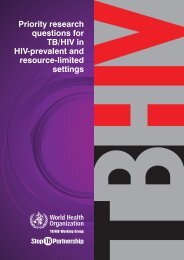
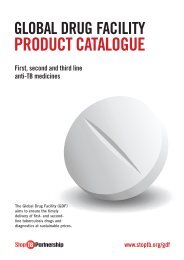
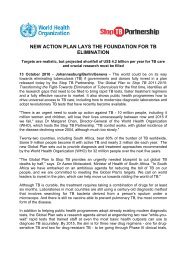
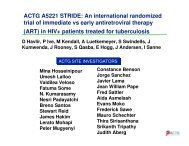
![Global Drug Facility Annual Report 2011 [.pdf] - Stop TB Partnership](https://img.yumpu.com/26788745/1/184x260/global-drug-facility-annual-report-2011-pdf-stop-tb-partnership.jpg?quality=85)

![Concept note on national stop TB partnership [.pdf]](https://img.yumpu.com/26788741/1/184x260/concept-note-on-national-stop-tb-partnership-pdf.jpg?quality=85)
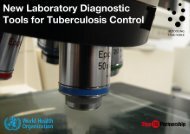

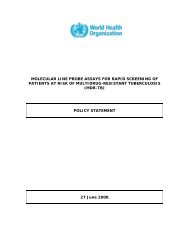
![2005 and Challenges for 2006 - 2015 [.pdf] - Stop TB Partnership](https://img.yumpu.com/26788674/1/190x245/2005-and-challenges-for-2006-2015-pdf-stop-tb-partnership.jpg?quality=85)
![Brochure (French) [.pdf] - Stop TB Partnership](https://img.yumpu.com/17234792/1/190x91/brochure-french-pdf-stop-tb-partnership.jpg?quality=85)

